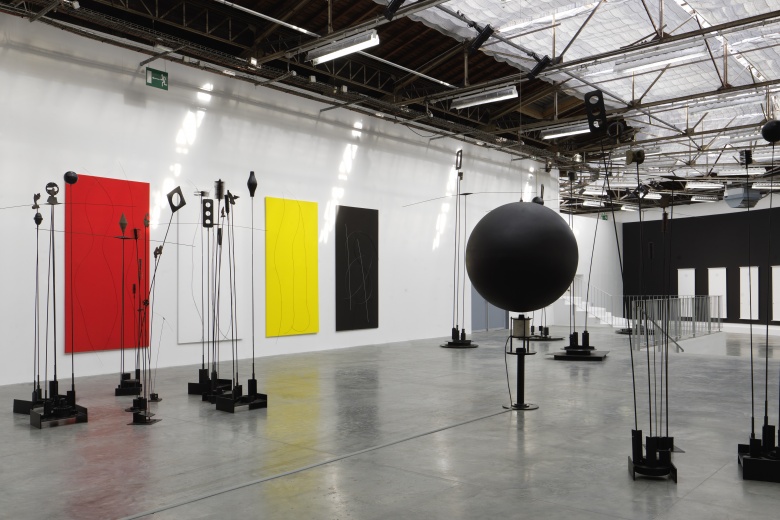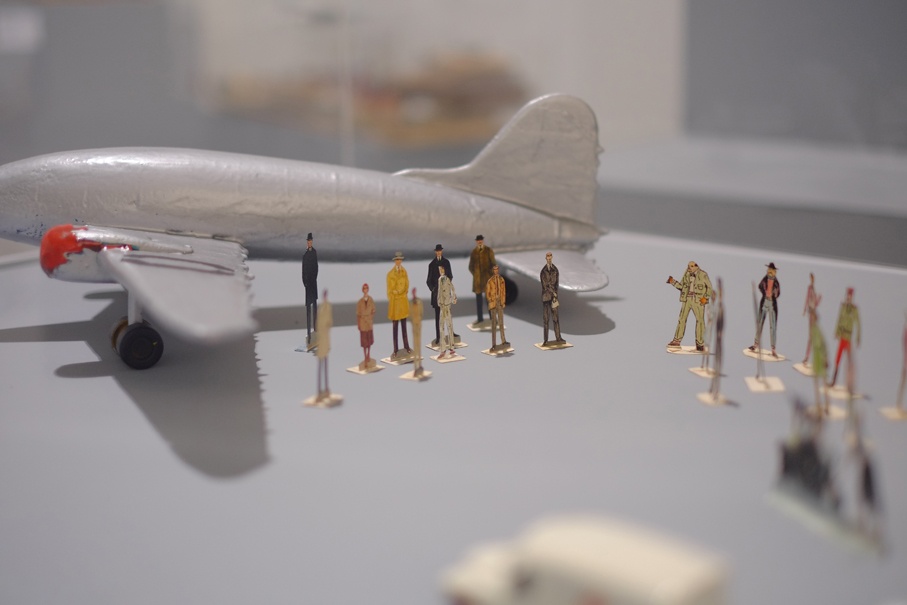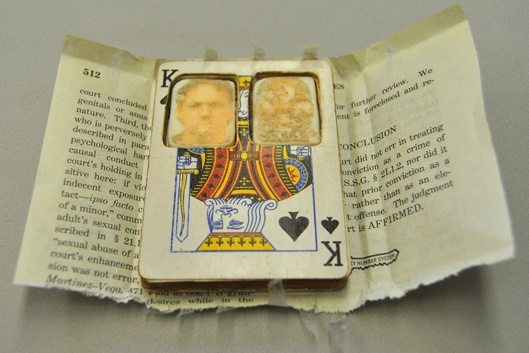Paris Diary - Palais de Tokyo

Palais de Tokyo is the only museum I'm aware of that is open till midnight, and for that reason alone, I love it. More museums should be open till midnight, at least once or twice a week.
There were several exhibitions when I went (all on till 17th May 2015), here are my highlights:
Bouchra Khalili - Foreign Office, Palais de Tokyo 2015. Photo : Aurélien Mole. © ADAGP, Paris

Bouchra Khalili - Foreign Office, Palais de Tokyo 2015. Photo : Aurélien Mole. © ADAGP, Paris
For her exhibition at the Palais de Tokyo, Bouchra Khalili presents a new series of works made up of films, photographs and documents. Produced in Algeria, this new project takes is part of the artist’s investigation over the last ten years into the forms and discourses of resistance as expressed by the members of minority groups that arise from these colonial and postcolonial histories.
With “Foreign Office”, Bouchra Khalili revisits the period spanning from 1962 to 1972 when Algiers became the “capital of the revolutionaries” after Algeria’s independence. The city opened its arms to the many militants of African, Asian and American liberation movements such as Eldridge Cleaver’s International Section of the Black Panther Party, the ANC (African National Congress) led by Nelson Mandela, the PAIGC (African Party for the Independence of Guinea and Cape Verde) led by Amilcar Cabral, and even the now-forgotten Popular Front for the Liberation of Oman and the Arab Gulf.
Taking as a starting point this facet of Algerian history whose piecemeal transmission, in the form of legend, has frozen it in the past, the film portrays two young Algerians of today who recount this history, questioning its traces and the reasons why it has been forgotten by their generation. Questions surrounding oral tradition, language and their relationship to the story and to history are at the film’s core and reveal an alternative historiography. The series of photographs establishes an inventory of the different places that welcomed these liberation movements based in Algiers, while a map made by the artist reinstates them within the city’s contemporary topography.

Takis, Palais de Tokyo 2015. Photo : André Morin. © ADAGP, Paris
This exhibition explores the "interstices between art and the sciences by paying tribute to the great sculptor and inventor Takis who will turn 90 in 2015". I was not familiar with his work, but the piece titled "Sculptures Musicales" is the one that impressed me the most. I couldn't take any photos of it or film it because my phone camera wasn't working, but I found this video online which should give you an idea of the piece.
About the piece from (via the catalogue):
"If only with an instrument such as radar, I could capture the music of the hereafter!... If only the object, as it turned, could capture sounds and transmit them." Takis, Estafilades, Paris: Julliard, 1961
Takis would realize his dream of a sound coming from the depths of the cosmos in his own way, with his Sculptures Muicales from the mid-1960s onwards. To do this, he installed an electromagnet behind a simple wood panel that attracted and repelled an upholsterer's needle that, in turn, would strike a strin producing a halting music. In some cases, electric light bulbs were inserted into the panels in such a way that they switched on and off to the rhythm of the sound. The device was of a great simplicity and its visual proposition very straightforward. The addition of more Sculptures Musicales with variations on the position of the needle or the tension of the cord produced a randomized music, both strange and harmonious. Music "from the hereafter."
About the overeall exhibition:
The first person to “send a man into space,” six months before Yuri Gagarin, during a famous performance, and who realized a monumental basin of light signals on the esplanade of La Défense in 1988 that thousands of people see every day, probably without knowing anything of their author, is a major figure in post-war art.
Born in Athens and based in Paris since the 1950s, Takis set about exploring magnetic field energy in his work. Working in proximity with his contemporaries of the New Realism movement, he integrated light and music in combination with the use of magnets into his sculptural practice.
From his exposition of magnetic forces to his “tribute to Kafka” and his erotically charged bronze sculptures, the exhibition brings together around fifty spectacular pieces. This is one of the most comprehensive solo exhibitions of Takis’ work since the Jeu de Paume’s show of 1993.
A tireless experimenter and “intuitive savant”, Takis has continuously sought to capture cosmic energy by combining art and science.
As a contemporary plastician, his work is grounded in a sculptural tradition that spans archaic Greek sculpture and Giacometti on the one hand and the rejects of technology on the other.
Fascinated by the “scientific magic” at the core of inventions (he even registered a number of industrial patents), Takis is also a science philosopher, regularly drawing inspiration from the great ancestors of pre-Socratic philosophy, Hippocratic medicine, and Ancient Egypt.
Le Bord des Monds (At the Edge of the Worlds)
Answering Marcel Duchamp’s question: “Can one make works of art which are not ‘of art’?”, the exhibition "Le Bord des Mondes (At the Edge of the Worlds)" explores the many fields of artistic creation and welcomes creative people from outside of the art world whose work would seem to belong to it through its depth, its beauty and its singularity. These artists – visionaries, experimenters, poets and pirates – reveal these unprecedented fields and defy limits.
The exhibition includes work by 24 artists/collectives and was quite intensive. The following are my favourites. You can see the rest here.


Kenji Kawakami (b. 1946, lives and works in Tokyo) invented chindogu, objects that he has been creating since the 1980s and who number today over one thousand unique specimens. These strange inventions are true manifestos of political, economic and poetic resistance. While they serve a function and are thus usable, they are nonetheless resolutely useless.
These manifestos, devised as responses to the laughable difficulties of men, develop like a fable disconnected from any practical meaning and prompt a reflection on the consumerism and materialism of modern life.
Following the 10 founding commandments of chindogu, each object must affirm its freedom and pleasure in being useless, must be universally understandable and must constitute a non-verbal form of communication. It must be “given to the world” and can therefore not be sold, filed, patented or even owned. As unidentified objects, the chindogu are for Kenji Kawakami “an intellectual game to stimulate the mind.”
Vue de l’exposition « Le Bord des Mondes », Palais de Tokyo, 2015. Photo : André Morin. Theo Jansen, Animaris Umerus, 2010. Courtesy de l'artiste. ADAGP, Paris 2015.
For over twenty years, Theo Jansen (b. 1948, lives and works in The Hague) has devoted himself to the study of an independent and autonomous species: Strandbeests or “beach creatures.” Every summer, he transforms Scheveningen beach into a laboratory where these monumental creatures are deployed. Made solely out of electrical insulation tubing and sometimes out of bamboo-sticks, cable ties and Dacron sails, they are moved by the wind’s force.
The Strandbeests species are developed according to the principles of evolution and genetic transformation, thereby questioning the widely accepted division between the natural and the artificial, the organic and the mechanical, and creating a complex genealogy.
Theo Jansen rejects our spontaneous anthropocentrism and considers the Strandbeests as having their own rationale, their own mechanisms and evolutionary principles of which he is not so much the inventor as the conveyor and transmitter.
Vue de l’exposition « Le Bord des Mondes », Palais de Tokyo, 2015. Photo : André Morin. Jerry Gretzinger, Jerry's Map, 1963-2014, Courtesy de Jerry Gretzinger.
Jerry’s map, 1963-2014, peinture sur papier, dimension variable, Courtesy Jerry Gretzinger
In 1963, Jerry Gretzinger (b. in 1942, lives and works in Mapple City, U.S.A.) drew the first element of the map to an imaginary world. Each day, the drawing was added to, expanding this world and mapping out the features of an unknown land with the appearance of cities such as “Plaeides” and “Ukrainia.”
Fifty years later, the cartographer is still working on this same document that has since morphed into a space made up of almost three thousand A4 sheets of paper. Every morning, Jerry Gretzinger picks a card out of a pack that he himself designed. The card tells him the change he must make that day: to add a building, take away some streets or create fallow land.
The world he is creating is born of the map’s own development as the layers of paper sediment on top of one another. These transformations are documented in an inventory, acting as a memory of the successive steps in the construction and modification of this universe.
Rose-Lynn Fisher, The brevity of time (out of order) losing you, 2011, Pigments sur papier, 28x35 cm, Courtesy Rose-Lynn Fisher et de Craig Krull Gallery, Los Angeles.
Through her study Topography of Tears, Rose-Lynn Fisher (b. 1955, lives and works in Los Angeles) has examined over a hundred tears hers and those of others using an optical microscope. Started in 2008 and made up of over a hundred images, the series qualified by the creator as “aerial views of emotional terrain” reveals the complexity and the elusive nature of the feelings that inhabit us. These tears are the result of fits of laughter, moments of doubt, grief or exasperation…
Rose-Lynn Fisher has concentrated on macro /micro photography for many years. Her research attempts to materialize and make visible through images, the physical manifestations of the intangible. The extreme variety and dissemblance between each of these tear studies reveal humanity’s infinite nature, the existence of a multitude of territories inside of us like so many worlds that can be revealed by photography; yet they remain “foreign” and indecipherable to us.
Game of States, Michał Slezkini Bohdan Slezkin 2015
Game of States was created around 1947 in Warsaw when Poland was integrating the Socialist bloc. Created by a few teenagers, the game was developed in the greatest secrecy in apartments where diplomatic conspiracies and military offensives were carried out in miniature between fictitious states: the parliamentary monarchy “Tiny Empire,” the social-democratic kingdom of “Niam Niam,” the communist dictatorship of the “United Materialistic Socialist Republics” and the “Republic of Poland.”
A fantastic maze of ideas and strategies, of official and unofficial plot twists imagined by its practitioners, Game of States has developed over several generations through letter exchanges, the creation of political characters, spies, media manipulations, fake accidents, and is still enriched today by Michal Slezkin. As a cathartic outlet, it has become the realization of an utopia where reality can be reinvented, dissolved and transformed from game to game.
Vue de l’exposition « Le Bord des Mondes », Palais de Tokyo, 2015. Photo : André Morin. Iroshi Ishiguro, Kouka, 2014. Courtesy d'Hiroshi Ishiguro et dévelopé par l'Université d'Osaka.
As a researcher in robotics intelligence in Osaka, Japan, Hiroshi Ishiguro (b. 1963, lives and works in Osaka) creates “geminoid” robots, machines that imitate in every way the appearance and the behavior of humans. These anthropomorphic robots are based on existing individuals, becoming their automatic replica with humid lips, expressive eyes and shining hair. The researcher is interested in the way in which man communicates and creates “natural” relationships with objects.
Beyond the technical and technological performance, Hiroshi Ishiguro is above all attempting to understand humanness, the reason for our existence. Does human nature exist? Can it be artificially produced and reproduced? Ishiguro uses robots in order to analyze man and his psychological makeup, his cognitive system, his sociability and what makes him human.
Jesse Krimes, Purgatory (1 of 292, detail), 2009. Page du « Federal Reporter» de la bibliothèque de droit des détenus, cartes à jouer collées avec de la mousse à raser et du dentifrice, morceaux de savon, portraits en transferts de journal. Courtesy de l’artiste.
During his incarceration in an American prison, Jesse Krimes (b. 1982, lives and works in Philadelphia, U.S.A.) invented for his co-prisoners and himself a means of symbolic escape with the materials given to him by the penitentiary administration.
He methodically cut out portraits of his peers in the newspaper, transferred these images onto bars of soap that he then dissimulated in card decks prepared for the purpose. In this way he was able to deceive the vigilance of the prison guards in order to release these hidden portraits in letters sent to the outside world.
These 300 or so portraits became proof of the existence of these hundreds of individuals absent from a world from which they have been banished. By bypassing the restrictions on freedom and symbolically reintegrating the existence of these ghosts into a territory whose access has been physically denied them, Jesse Krimes engaged in an act of resistance.
ARNOLD ODERMATT, Wil, Oberdorf, 1951 © Urs Odermatt, Windisch. Courtesy Galerie G-P & N Vallois, Paris et Galerie Spinger Berlin © ADAGP, Paris 2015
Arnold Odermatt (born in 1925, Switzerland) was a police officer in the Nidwalden canton, who as a passionate photographer preferred this medium over the customary sketches used for accident reports.
For more than sixty years, he photographed the canton police’s daily life, which he captures with a singular vision. He produced the series Karambolage, a sequence of photographs of accidents, where humor replaces tragedy, and composition replaces information. The lines on the road, tracing the cars’ trajectories prior to collision, illustrate Odermatt’s discerning eye in the framing and composition of his pictures.
His photographs were revealed in 1990, when they were discovered by his son, Urs Odermatt.
www.palaisdetokyo.com/en/exhibition/bouchra-khalili
www.palaisdetokyo.com/en/exhibition/takis
www.palaisdetokyo.com/en/le-bord-des-mondes
www.palaisdetokyo.com/en/exhibition/kenji-kawakami
www.palaisdetokyo.com/en/exhibition/theo-jansen
www.palaisdetokyo.com/en/exhibition/jerry-gretzinger
www.palaisdetokyo.com/en/exhibition/rose-lynn-fisher
www.palaisdetokyo.com/en/exhibition/game-states
www.palaisdetokyo.com/en/exhibition/hiroshi-ishiguro









